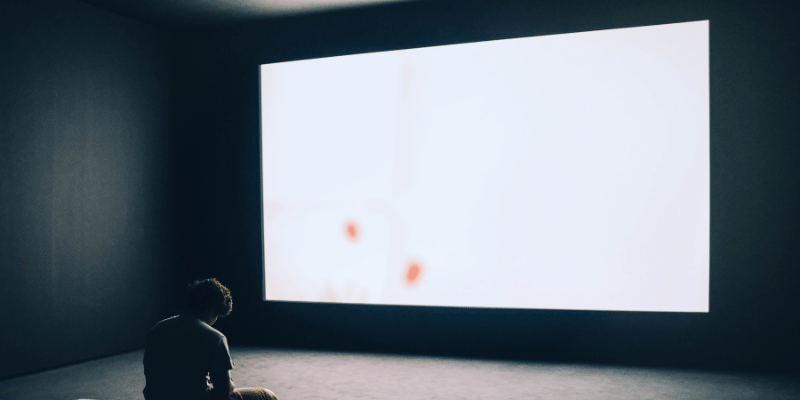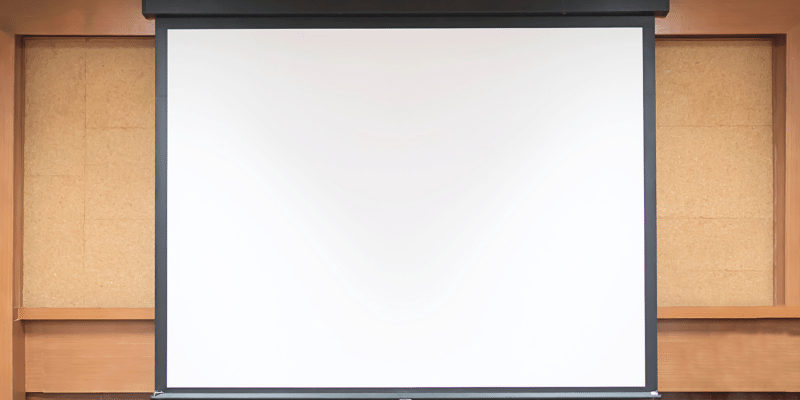A home theater setup or an office presentation is incomplete without high-quality projection screens. The market is flooded with projector screens for specific needs and purposes.
For a novice, the good place to start is to decide between tensioned and non-tensioned projection screens.
Tensioned vs Non-Tensioned Projection Screen
The main difference between the Tensioned and non-tensioned screens is not only the quality of the image.
These two projection screens differ from each other in several ways including durability, price, functionality, and application.
First, it is important for a user to know about these two screens, compare their working, and ultimately choose the best.
Tensioned Projection Screen

These projection screens are generally expensive but free from curling or creases. As the screen is entirely flat, expect high-definition images and resolution.
Manufactured from vinyl material, it is attached to a fixed frame and a motorized system that pulls the screen down.
Permanently tensioned screens and Tab-tensioned screens are the two popular types of this screen.
Non-Tensioned Projection Screen

This projection screen can be compared to a bedsheet and is prone to rolling and creases.
Not attached to a fixed frame or other support but held up by the casing structure.
Available at an affordable price, a Non-tensioned projection screen is better suited for indoor use without being disturbed by outdoor elements. They need additional support and work well as wall projector screens.
Difference Between Tensioned and Non-Tensioned Projector Screen
Look at some of the main differences between these two projector screens.
Application
- Non-Tensioned Projection Screen – This projector screen is generally used indoors to not ruin your viewing experience with strong winds and other outdoor elements.
- Tensioned Projection Screen – It stays in place owing to the tabs and fixed frame. This screen withstands airflow and fits outdoor venues for business functions.
Portability
- Non-Tensioned Projection Screen – This screen wins the race of portability. It is portable and easy to pack. Transport it anywhere safely and easily.
- Tensioned Projection Screen – Tensioned screens can be a bit difficult to pack and haul owing to the tabs and snaps.
Functionality
- Non-Tensioned Projection Screen – These screens can be ceiling-recessed or wall-mounted, and either pulled down manually or through a motorized system. These motorized screens have infrared and radio frequency remote control technology and a tubular motor that makes the screen move.
- Tensioned Projector Screen – Permanently tensioned screens are bulky and stay rigid due to the tabs and the frame. Tab-Tensioned screens are multipurpose, offer versatility to the user experience, and can be rolled into one headbox.
Material
- Non-Tensioned Projector Screen – Made from an affordable material, elastic polyester. This fabric is portable, washable, and foldable while offering good quality.
- Tensioned Projector Screen – It is made from an expensive, high-quality vinyl material that has an edge over the polyester fabric.
Price
- Non-Tensioned Projector Screen – Hands down, these screens are cheaper and the difference is several hundred dollars.
- Tensioned Projector Screen – Though this screen is expensive, it makes up for the extra few hundred dollars with high-end quality and unparalleled user experience.
Durability
- Non-Tensioned Projector Screen – It lacks the optimum durability that the Tensioned screen has to offer.
- Tensioned Projector Screen – Made from vinyl and other specialized materials, it is durable, anti-crease, weatherproof, and rustproof.
Viewing Experience
- Non-Tensioned Projector Screen – If color accuracy and high-quality image are not an absolute necessity, go for the affordable option.
- Tensioned Projector Screen – It is a versatile choice providing the flattest screen for corporate settings or home theater. Fit for professional use and accurate display.
Conclusion
After knowing the differences between the two, purchase the projection screen that suits your budget and needs.

